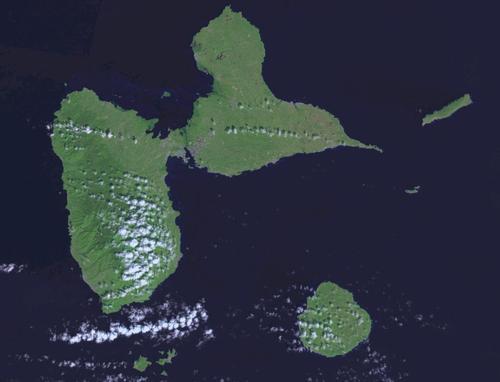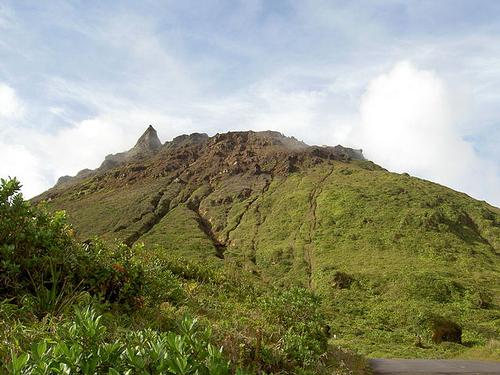GUADELOUPE

Geography and Landscape
Geography
Guadaloupe is a piece of France in the Caribbean. The island then belongs to the French Antilles and is a department of France. Guadeloupe is the largest island of the French Antilles and lies in the middle of the chain of the Lesser Antilles. Guadeloupe actually consists of two islands separated by a narrow saltwater channel, the Rivière Salée. Seen from the air, Guadeloupe is shaped like a giant butterfly.

Landscape
Guadelope used to be called the island of beautiful waters. The volcanic landscape is enriched with numerous waterfalls and hot springs. Nowadays, the inhabitants call it 'the green emerald'. They refer to the tropical rainforests, banana plantations and sugar cane fields that define the landscape. On the coast you will find fine-grained sandy beaches.
The eastern part of Guadeloupe is called Grande-Terre (Big Country) and the western part Basse-Terre (Low Country). Basse-Terre covers an area of over 800 square kilometres and is the larger of the two islands. A volcanic mountain range runs across the island. In the south of Basse-Terre is the highest peak of Guadeloupe and also of the Lesser Antilles, the still active stratovolcano La Grande Soufrière (1,467 m). There are many banana plantations on Basse-Terre.
 La Grande Soufrière, highest peak of GuadeloupePhoto: Ofol CC BY 2.5 no changes made
La Grande Soufrière, highest peak of GuadeloupePhoto: Ofol CC BY 2.5 no changes made
The island of Grande-Terre is smaller, flatter and drier and covers an area of 570 square kilometres. Grande-Terre is home to vast sugarcane plantations where delicious rum is made. Along the coast with its many coral reefs lie beautiful sandy beaches. The most beautiful sandy beaches lie on the south coast of Grande-Terre and in the north of Basse-Terre. Around Guadeloupe are the islands of Marie-Galante, Iles de Saintes and La Désirade.
Climate and Weather
The climate on Guadeloupe is tropical. From November to April is the dry season with an average daytime temperature of 25°C, the water temperature is summery and in the autumn about 24 degrees. From April to November, the temperature regularly exceeds 30°C, interspersed with tropical showers. At night, the temperature rarely drops below 20 degrees. Hurricanes may occur occasionally in the autumn.
Plants and Animals
Plants
The watery and green Basse-Terre contrasts with the dry and arid Grande-Terre. Many slopes of volcanoes on Basse-Terre are covered with extensive rainforests. Numerous tropical tree species grow in these forests, including mahogany trees, rubber trees and gourds. Common flowering plant species are hibiscus and bougainvillea. Numerous orchid species are found on the island. In total, there are no less than 300 species of trees and plants in Guadeloupe.
Animals
Many bird species can be found on the island; in particular, the forests are the domain of numerous tropical bird species. There are also buntings (a species of finch) and blackbirds. Well known is the small hummingbird, which sucks honey from flowers with its relatively small beak and is able to move its wings at a speed of 100 beats per second, so that it can hover in the air.
The Guadeloupe raccoon is Guadeloupe's most famous animal. These raccoons live in the Guadeloupe National Park on Basse-Terre. This small rodent is rare and protected. On the islands Les Saintes and La Désirade there are many iguanas or comb lizards (iguana). Thanks to their camouflage colour, they are inconspicuous against the background of green bushes and grey rocks. A striking detail is the enormous tail of the animal, which sometimes covers three quarters of the total length of the animal. None of the snake species found on Guadeloupe are poisonous.
The beautiful coral reefs in the crystal-clear Caribbean Sea are teeming with multi-coloured coral fish, anemones and rare coral species. Other common water inhabitants are: blue marlin, tarpon, dolphin, bonefish, barracuda and kingfish.
Sources
Elmar Landeninformatie
CIA - World Factbook
BBC - Country Profiles
Copyright: Team The World of Info